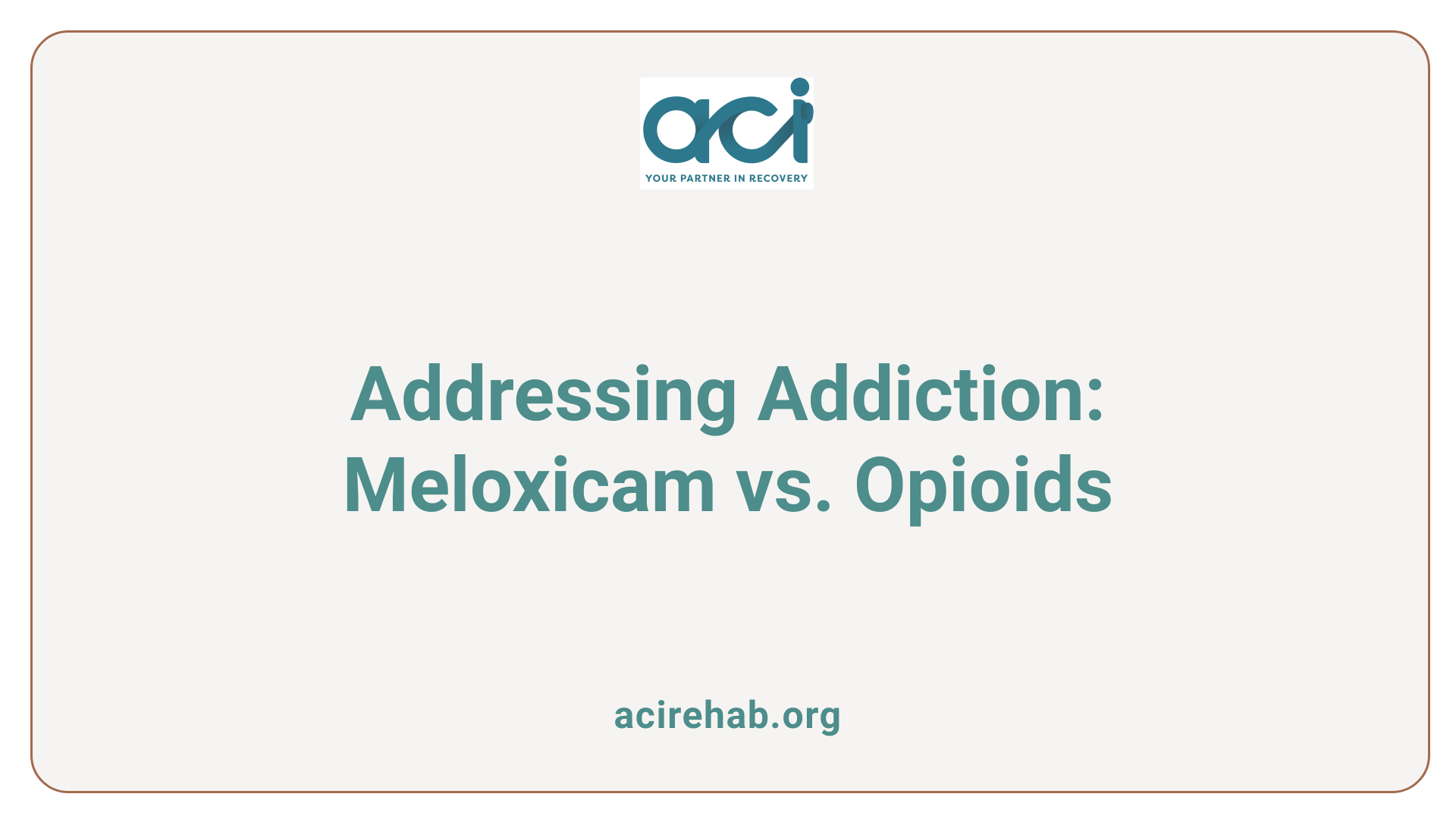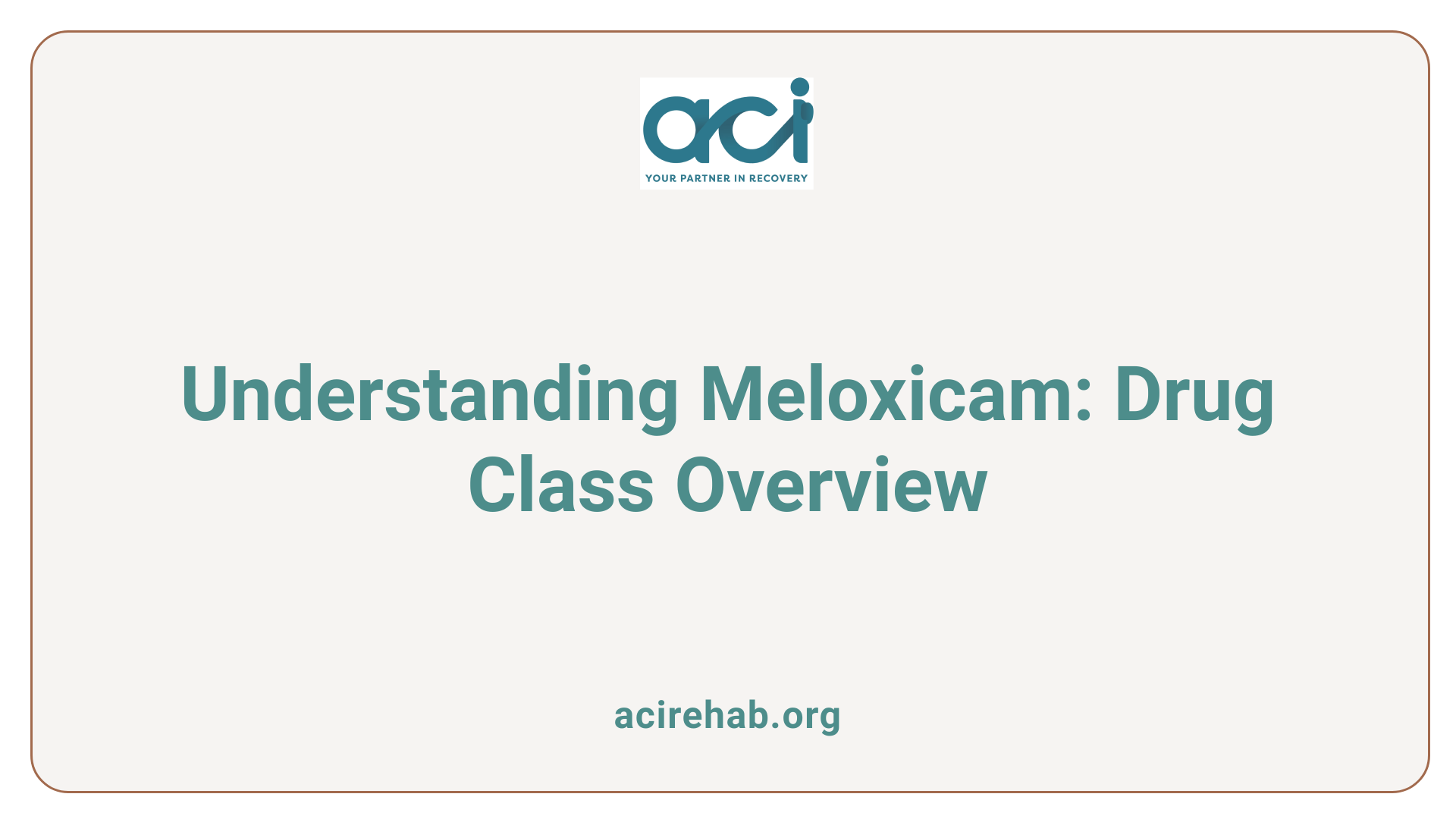Introduction to Meloxicam’s Usage and Misuse
Meloxicam is a medication commonly prescribed for managing pain and inflammation due to conditions like osteoarthritis and rheumatoid arthritis. Despite its widespread use, misconceptions prevail regarding its potential to produce euphoric sensations, similar to opioid misuse. This article seeks to clarify Meloxicam’s pharmacological classification, its effects, side effects, and the erroneous belief that it can induce a high. Understanding its proper medical usage is crucial to prevent misuse and ensure patient safety.
Is Meloxicam Addictive?

Addictive nature of Meloxicam
Meloxicam is not considered an addictive drug. As a nonsteroidal anti-inflammatory drug (NSAID), it is prescribed primarily for pain and inflammation related to conditions like osteoarthritis and rheumatoid arthritis. Unlike opioids, meloxicam does not bind to opioid receptors in the brain or engage the reward pathways responsible for feelings of pleasure. This means it does not induce euphoria or cravings typically associated with addiction.
Differences from opioids
While meloxicam is effective for pain relief, it has a significantly different profile from opioids. Opioids can cause severe withdrawal symptoms and cravings, leading to physical dependence. In contrast, meloxicam generally does not lead to withdrawal effects, although patients with chronic pain may find their discomfort increases upon discontinuation. Some individuals may misuse meloxicam under the false impression that it has opioid-like effects, leading them to use it beyond prescribed levels. However, even in misuse scenarios, meloxicam does not produce a high, thus reducing its potential for addiction compared to opioids. Overall, while meloxicam can be misused, it lacks the addictive qualities typical of narcotic painkillers.
Meloxicam: Understanding its Drug Class and Effects

Classification of Meloxicam
Meloxicam is classified as a nonsteroidal anti-inflammatory drug (NSAID). This group of medications is utilized primarily to reduce inflammation and relieve pain. Meloxicam is commonly prescribed for conditions such as osteoarthritis and rheumatoid arthritis, where inflammation and joint pain are prevalent.
Unlike narcotics or opioids, meloxicam does not produce euphoria or a high, making it distinct regarding addiction potential. It is not classified as a narcotic or a controlled substance, which further lowers its risk of misuse. Instead, its mechanism involves inhibiting the production of prostaglandins, substances that cause pain and inflammatory responses in the body.
Comparison to Opioids
Is meloxicam an opioid? No, meloxicam is not an opioid. It is an NSAID, functioning differently from opioids in managing pain. While opioids are often associated with serious addiction and can lead to euphoric sensations, meloxicam does not activate the brain’s reward pathways linked to pleasure and addiction.
Although meloxicam is seen as a safer alternative for pain relief, misuse can still occur, particularly among individuals who mistakenly believe it can induce a high similar to opioids. It’s crucial for patients to use meloxicam as prescribed to avoid possible health risks, such as gastrointestinal discomfort or kidney problems. Responsible use and consultation with healthcare professionals can mitigate these risks.
Can Meloxicam Cause a High or Euphoric Feelings?
Euphoric effects of Meloxicam
Meloxicam is classified as a nonsteroidal anti-inflammatory drug (NSAID) primarily used to alleviate pain and inflammation related to conditions such as arthritis. One of its defining characteristics is that it does not produce a high or euphoric feelings, which distinguishes it from opioids and other narcotics that actively engage the brain’s reward pathways.
While some individuals may misuse meloxicam under the misconception that it can provide euphoric effects similar to opioids, this assumption is inaccurate. Misuse is typically characterized by taking larger doses than prescribed, which does not enhance pain relief and can lead to severe side effects instead.
It’s crucial to note that even though meloxicam is not considered addictive, misuse can have harmful consequences. Serious risks associated with misuse include gastrointestinal bleeding, liver issues, and kidney damage.
To summarize, meloxicam should always be used as directed by healthcare professionals to mitigate risks and ensure effective pain management without the false expectation of experiencing a high, which it simply does not provide.
| Aspect | Meloxicam | Opioids |
|---|---|---|
| Primary Use | Pain relief and reduction of inflammation | Pain relief and potential euphoria |
| Addictive Potential | Minimal; not considered addictive | High; can lead to addiction |
| Euphoric Effects | None | Yes |
| Common Misuse Signs | Overuse beyond prescribed amounts | Seeking euphoria or high |
Common and Serious Side Effects of Meloxicam
What are the common effects and side effects of meloxicam?
Meloxicam, known by its brand name Mobic, is widely used for treating pain and inflammation, particularly in conditions like osteoarthritis and rheumatoid arthritis. While it can effectively alleviate symptoms, it’s important to be aware of both common and serious side effects associated with its use.
Common Side Effects
Meloxicam may cause:
- Stomach Upset: Nausea, heartburn, and stomach pain are frequently reported.
- Diarrhea: Digestive upset can occur, affecting some users.
- Headaches: Tension and headaches could manifest during treatment.
- Joint Pain and Swelling: Although meloxicam aims to relieve these symptoms, some patients may also experience discomfort.
These common side effects typically occur in about up to 8% of users and may subside as the body adjusts to the medication.
Serious Side Effects
On the more serious end of the spectrum, meloxicam can present risks including:
- Stomach Ulcers and Bleeding: Long-term use may lead to gastrointestinal issues.
- Kidney and Liver Damage: Impaired function of these organs can result from excessive use.
- Cardiovascular Risks: Increased chances of heart attack or stroke, especially in those with existing conditions.
Patients must remain cautious about potential interactions with alcohol, blood thinners, and other nonsteroidal anti-inflammatory drugs (NSAIDs), which can elevate risk levels significantly. It’s crucial to consult healthcare providers to assess individual risks and monitor responses while on meloxicam.
Misuse and Health Risks Associated with Meloxicam
Misuse Potential
Meloxicam is often misunderstood, leading some individuals to misuse it under the false belief that it acts like a narcotic. Although it is a nonsteroidal anti-inflammatory drug (NSAID) prescribed for pain relief, particularly in conditions like arthritis, it does not produce euphoric effects. Instances of meloxicam misuse have been reported, particularly among individuals with a history of opioid use disorder. They might take higher doses than prescribed, mistakenly thinking that this will enhance pain relief.
Health Risks
Despite not being addictive, meloxicam carries significant health risks, especially when misused. Taking it in higher doses can lead to serious complications such as:
| Health Issue | Description | Consequences |
|---|---|---|
| Gastrointestinal issues | Includes stomach ulcers and gastrointestinal bleeding. | Potentially life-threatening. |
| Kidney damage | Overuse can severely impair kidney function. | May require dialysis treatment. |
| Cardiovascular problems | Increased risk of heart attack and stroke. | Long-term implications for heart health. |
Therefore, it is crucial to use meloxicam responsibly and under a healthcare provider’s supervision to mitigate these risks.
Preventing Misconceptions: Meloxicam is Not a Recreational Drug

Common Misconceptions
Many individuals mistakenly believe that Meloxicam, a nonsteroidal anti-inflammatory drug (NSAID), can produce a euphoric high akin to that of opioids. Unlike these addictive substances, Meloxicam does not alter mood or perceptions. It primarily serves to reduce pain and inflammation associated with conditions such as arthritis, making it ineffective as a recreational drug.
Impact of Misuse
Misuse of Meloxicam can occur, driven by the false belief that it behaves like narcotics due to its pain-relieving properties. This misunderstanding may lead individuals with a history of opioid use disorder to take higher doses than prescribed. However, such misuse does not produce the desired effects of intoxication and can instead result in serious health risks, including gastrointestinal issues and kidney problems. Being aware of these misconceptions is crucial for promoting safe medication practices.
Meloxicam and Long-term Use: Potential Consequences

Long-term health risks
While meloxicam is effective for treating pain and inflammation, particularly in conditions like arthritis, misusing it over an extended period can lead to serious health risks. Potential adverse effects of long-term meloxicam use include:
- Gastrointestinal issues: Prolonged use can lead to ulcers and gastrointestinal bleeding.
- Kidney damage: Elevated doses or long-term non-compliance may affect kidney function.
- Cardiovascular risks: There is an increased risk of heart problems, including hypertension.
These consequences underline the importance of adhering to prescribed doses and duration.
Proper usage guidelines
Meloxicam is not a narcotic, meaning it is not intended to induce a high or euphoric feeling. To minimize risks:
- Use meloxicam strictly as prescribed by a healthcare professional.
- Avoid increasing doses without consultation, as this does not enhance efficacy but raises the risk of side effects.
- Regularly review treatment with your doctor, especially if your condition improves or you experience side effects.
Understanding meloxicam’s use and risks aids in effective management of your pain and inflammation.
Understanding Proper Use of Meloxicam
Dosage and Administration
Meloxicam is a nonsteroidal anti-inflammatory drug (NSAID) commonly prescribed for conditions like osteoarthritis and rheumatoid arthritis. When using meloxicam, it is vital to adhere to the prescribed dosage. Typically, it is taken once daily, and dosages will vary based on individual needs and health factors. Always consult your healthcare provider for the appropriate dose, as higher dosages can lead to serious side effects, such as gastrointestinal bleeding and kidney issues.
Avoiding Misuse
Misuse of meloxicam can occur, particularly among individuals who mistakenly believe it behaves like an opioid. Misunderstandings about its properties can lead to taking more than the recommended dose, which poses health risks without yielding additional pain control. Signs of misuse include taking the medication more frequently than prescribed, or using it for non-medical purposes.
Key Considerations for Safe Use
| Consideration | Recommendation | Potential Risks |
|---|---|---|
| Dosage adherence | Take as prescribed by your doctor | Overdose leading to serious health issues |
| Awareness of side effects | Be aware of potential side effects like stomach pain | Increased risk of adverse reactions |
| Consultation before adjustments | Always talk to your healthcare provider before changing dosage | Increased chance of complications |
Using meloxicam responsibly is essential to ensuring its efficacy and minimizing potential health risks.
Meloxicam’s Role in Pain Management Versus Opioids
Comparison to Opioids in Pain Management
Meloxicam, a nonsteroidal anti-inflammatory drug (NSAID), is primarily used to alleviate pain and inflammation, particularly in chronic conditions like osteoarthritis and rheumatoid arthritis. Unlike opioids, which target the brain’s reward pathways to induce euphoria, meloxicam operates by inhibiting the production of prostaglandins that contribute to pain and inflammation. This distinction fundamentally influences their respective risk profiles regarding misuse and addiction.
Some individuals may mistakenly believe that meloxicam functions like an opioid painkiller and use it inappropriately. However, meloxicam does not produce a euphoric high, and its addictive potential is exceedingly low compared to opioids, making it a safer alternative for pain management.
Safety Profile
While meloxicam is not without risks, it does not induce the same high associated with opioids, thus reducing its likelihood of misuse. Common side effects include gastrointestinal issues or cardiovascular effects when misused. Additionally, the absence of psychoactive properties means there is minimal risk of addiction or withdrawal symptoms, although psychological dependence may still develop in some cases.
| Aspect | Meloxicam | Opioids |
|---|---|---|
| Addiction Risk | Minimal; not habit-forming | High; significant risk |
| Euphoria | No euphoria or ‘high’ | Induces euphoria |
| Side Effects | Gastrointestinal issues, potential for ulceration | Respiratory depression, overdose |
| Use | Chronic pain management, especially arthritis | Acute and severe pain management |
In summary, meloxicam serves as a valuable option in managing pain without the severe risks often associated with opioid use.
Conclusion: Safe and Effective Use of Meloxicam
In conclusion, meloxicam is a valuable medication for managing pain and inflammation in arthritic conditions. It is important for both patients and healthcare providers to recognize that meloxicam is not an opioid and does not produce euphoria, thereby minimizing the risk of addiction. However, misconceptions and misuse can lead to serious health issues. By understanding its proper use, side effects, and staying informed about its pharmacological nature, users can maximize its benefits while avoiding potential pitfalls. As with any medication, consulting with healthcare professionals is essential to guide safe and effective treatment outcomes.
References
- What Is Meloxicam (Mobic) and How Is It Abused?
- Meloxicam Addiction: Is Meloxican a Narcotic and Does it Get You …
- Can Meloxicam Get You High? – Conifer Park
- Can Meloxicam Get You High? – Arista Recovery
- Can Meloxicam Get You High? – Steps to Recovery
- Can Meloxicam Get You High? – Townsend
- Meloxicam (Mobic): Can You Abuse It? – Sunshine Behavioral Health
- Can Meloxicam Get You High? – Samba Recovery
- The Truth About Meloxicam: Can You Really Get High from Taking It?

